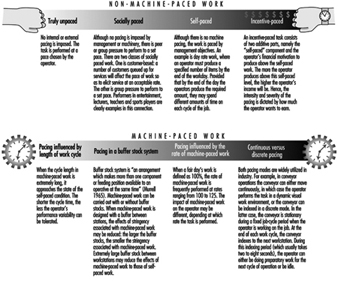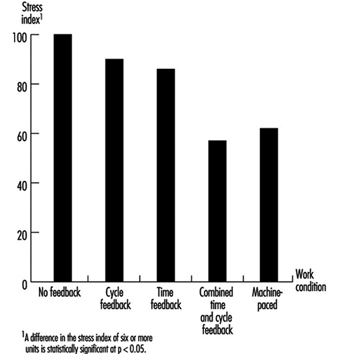In this article, the reasons machine-pacing is utilized in the workplace are reviewed. Furthermore, a classification of machine-paced work, information on the impact of machine-paced work on well-being and methodologies by which the effects can be alleviated or reduced, are set forth.
Benefits of Machine-Paced Work
The effective utilization of machine-paced work has the following benefits for an organization:
- It increases customer satisfaction: for example, it provides speedier service in drive-in restaurants when a number of stations are assigned to serve the customers sequentially.
- It reduces overhead cost through economic use of high technology, reduction of stock set aside for processing, reduction in factory floor space and reduction in supervisory costs.
- It reduces direct costs through reduced training time, lower hourly wages and high production return per unit of wages.
- It contributes to national productivity through provision of employment for unskilled workers and reduction in the production costs of goods and services.
Classification of Machine-Paced Work
A classification of paced work is provided in figure 1.
Figure 1. The Job Stress Model of the National Institute for Occupational Safety and Health (NIOSH)
Effect of Machine-Paced Work on Well-Being
Machine-paced research has been carried out in laboratory settings, in industry (by case studies and controlled experiments) and by epidemiological studies (Salvendy 1981).
An analysis was performed of 85 studies dealing with machine-paced and self-paced work, of which 48% were laboratory studies, 30% industrial, 14% review studies, 4% combined laboratory and industrial, and 4% conceptual studies (Burke and Salvendy 1981). Of the 103 variables used in these studies, 41% were physiological, 32% were performance variables and 27% psychological. From this analysis, the following practical implications were derived for the use of machine-paced versus self-paced work arrangements :
- Tasks with high cognitive or perceptual load should be administered under self-paced as opposed to machine-paced conditions.
- To reduce error and low productivity, jobs should be allocated according to the worker’s personality and capacities.
- Intelligent, shrewd, creative and self-sufficient operators prefer to work on self-paced rather than machine-paced tasks. (See table 1 for more complete psychological profiles.)
- Workers should be encouraged to select a workload capacity which is optimum for them in any given situation.
- To maintain a high activation level (or the required level for performing the task), the work sessions should be interrupted by rest periods or by other types of work. This type of break should be implemented before the onset of deactivation.
- Maximal work speeds are not economical and can result in workers’ becoming overstrained when they continue to work excessively fast for a long time. On the other hand, too low a speed may also be detrimental to workers’ performance.
In studying industrial workers for an entire year in our experimentally controlled situation, in which over 50 million data points were collected, it was shown that 45% of the labour force prefers self-paced work, 45% prefers machine-paced work, and 10% does not like work of any type (Salvendy1976).
Table 1. Psychological profiles of operators who prefer self-paced and machine-paced work
|
Machine-paced work |
Self-paced work |
|
Less intelligent |
More intelligent |
|
Humble |
Assertive |
|
Practical |
Imaginative |
|
Forthright |
Shrewd |
|
Group-dependent |
Self-sufficient |
Uncertainty is the most significant contributor to stress and can be effectively managed by performance feedback (see figure 2) (Salvendy and Knight 1983).
Figure 2. Effects of performance feedback on reduction of stress

